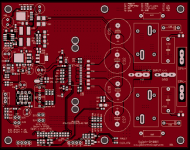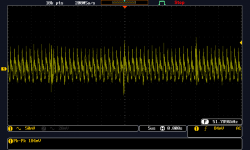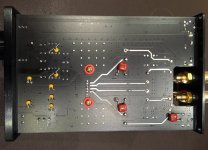D
Deleted member 148505
Sorry this is not a allo thread.
I think that JLP has done a great job especially with BTL. JLP try to use PBTL you should gain some db .
Thanks, I already sent the PBTL mono module to the manufacturer, We expect it to arrive next week (but there's a looming Delta Variant preemptive lockdown in our place)
I placed screw mounts for 2 types of ATS heatsink so supply issue will not be a problem.
Then LM2940 for TPA3255 xVDD and split supply LM317(input from LM2940) + TPS7A3001 for the opamp. Since using TPS7A4901 looks overkill.
PFFB can be enabled/disabled by easily accessible jumpers on top PCB.
This will redeem the Sylph-D name for SINAD and power rating hehe
Board size 100 x 130mm so it can fit in a smaller chassis.
Attachments
Last edited by a moderator:

On this occasion the posts have been deleted but this case is the exception and not the rule. One of the posts in one of the two threads also contained a 'base64' image @ literally hundreds of thousands of characters length which throws the server and prevents other images on the page loading correctly.
D
Deleted member 148505
If anyone wants more 'air' with their TPA3255.
I've extracted OPA1678 from my MOTU M4, and it sounds good in my TPA3255.
It has the sound characteristics of OPA1656 and has the 'grit' and 'air' of LME49860. I like it better than OPA1692 in my Sylph-D200.
Though this SOIC-8 IC is out of stock in most electronics distributors.
Thanks you for the trust 🙂
I've extracted OPA1678 from my MOTU M4, and it sounds good in my TPA3255.
It has the sound characteristics of OPA1656 and has the 'grit' and 'air' of LME49860. I like it better than OPA1692 in my Sylph-D200.
Though this SOIC-8 IC is out of stock in most electronics distributors.
Congrats on the excellent review Jlester! Really looking forward to receiving my board now 🙂
Thanks you for the trust 🙂
Last edited by a moderator:
Thanks for the comments
In the Class D branch, I have to compare TDA7498, TPA3116D 50 + 50W and TPA3116D Dual Chip 100 + 100W, TPA3118 Dual Chip, STA508 and PAM8106.
My reference amplifier is a AB mosfet amplifier designed by a Brazilian designer (no, it is not a DX) that has been rated as one of the best DIY amplifiers designed in Brazil.
I hope to have fun moments of comparison and especially great auditions.
And what amplifier is that?
And what amplifier is that?
Yes, I'm Brazilian and would like to know that too. Any schematics?
Is it better to run the TI TPA3255 evaluation module at 36v instead of 48v to get lower noise ?
Any chance someone can help me find the last board version for this project, and save from reading 416 pages?
Would love to see that too, also wish someone could document/collect all the possible successful well tested mods in one single post

Bought an Aiyma A07 just to see (or hear) how far class D has progressed, especially at this low price. So far I have not made any critical listening sessions, even so, I remain pleasantly happy with the sound quality. My other amp is an Audiolab 8200 for comparison.
Posting because I'm sharing a few of oscilloscope traces for your interest. These show switching noise on the main supply rails. This noise is most likely due to the digital switching noise when the TPA3255 is operating. There is little that can be done to reduce this noise since accessibility to circuitry is blocked by the heatsink and the fact there is little spare room inside the small case. I did add a few supply decoupling caps to the main supply and across the 12V preamp supply. These made only a very small difference to the noise amplitude.
The first scope trace shows the main supply rail when the TPA is asleep (the A07 has a switch on the front panel. There is a fast pulse coming from the switched mode PSU running at 66kHz, the pulse causing a ringing at about 20MHz that decays rapidly in about 500ns. The second scope trace shows the same main supply rail when the TPA is awake. Wow, the digital noise from the TPA eclipses the noise from the SMPS. Guessing now but I'd suspect that some of this noise will make it onto the analogue section of the TPA.
Note that the frequency of the supply noise is well above the audio range. Even so, the circuitry or layout could be improved to eliminate this noise.
The last attachment shows where the decoupling capacitors where added, these had to be physically small to fit between the PCB and the case. As stated already, they did make a difference but only very small.
Posting because I'm sharing a few of oscilloscope traces for your interest. These show switching noise on the main supply rails. This noise is most likely due to the digital switching noise when the TPA3255 is operating. There is little that can be done to reduce this noise since accessibility to circuitry is blocked by the heatsink and the fact there is little spare room inside the small case. I did add a few supply decoupling caps to the main supply and across the 12V preamp supply. These made only a very small difference to the noise amplitude.
The first scope trace shows the main supply rail when the TPA is asleep (the A07 has a switch on the front panel. There is a fast pulse coming from the switched mode PSU running at 66kHz, the pulse causing a ringing at about 20MHz that decays rapidly in about 500ns. The second scope trace shows the same main supply rail when the TPA is awake. Wow, the digital noise from the TPA eclipses the noise from the SMPS. Guessing now but I'd suspect that some of this noise will make it onto the analogue section of the TPA.
Note that the frequency of the supply noise is well above the audio range. Even so, the circuitry or layout could be improved to eliminate this noise.
The last attachment shows where the decoupling capacitors where added, these had to be physically small to fit between the PCB and the case. As stated already, they did make a difference but only very small.
Attachments
Thanks, I already sent the PBTL mono module to the manufacturer, We expect it to arrive next week (but there's a looming Delta Variant preemptive lockdown in our place)
I placed screw mounts for 2 types of ATS heatsink so supply issue will not be a problem.
Then LM2940 for TPA3255 xVDD and split supply LM317(input from LM2940) + TPS7A3001 for the opamp. Since using TPS7A4901 looks overkill.
PFFB can be enabled/disabled by easily accessible jumpers on top PCB.
This will redeem the Sylph-D name for SINAD and power rating hehe
Board size 100 x 130mm so it can fit in a smaller chassis.
How is the mono module progressing? What is the expected power rating into 8/4 Ohms?
D
Deleted member 148505
How is the mono module progressing? What is the expected power rating into 8/4 Ohms?
You can check my vendor thread for the updates. Thank you!
Amplifier Modules and PCBs For Sale
Got my TPA3255 board and a mean well 36v psu. looking to hook this up to a raspberry pi with a hifiberry dac2 hd. But when I do I get a lot of noise. hooking the dac2 to my AV receiver and it sounds great. So do I need some pre-amp between the dac2 and the tpa3255? thought it had a pre-amp integrated...
Hi
I have BRZHIFI TPA3255 amplifier and i used it a while ....
I have an most Important Problem ..
the right channel is 1-2dB less than the left channel
So i measured a little.
What do i have now...
12v - LM2575HVS 470uH 220/25V ( measured 180mV ripple with 50khz Spikes - switching frequency )
TPA3255 AVCC ist only a simple 4R7 100nF circruit
(measured 170mV ripple with 50khz spikes )
OPV supply : Same Like AVCC .. but 47R with 100uF/25V
(Measured 150mV ripple with Same 50khz Spikes )
And also Vopv/2 with Lots of ripple and Spikes
Output of amplifier ~ 750mVpp @460khz in every Output
Also you can See the 50khz switching Spike ...
So i changed a bit some parts ..
Unknown SMD Caps removed and soldered some new nichicon/Panasonic Caps
Removed 470uH inductor and use a 220uF shielded Würth Type
This new 12V hast a ripple of 40mV ...without any Spikes.
.. 40mV ist good for this Type of regulator IMHO
Added a 1000uH + 470uF Filter top Feed the analog Part.
And added some 100uF Caps ...
Here you can read 20mV ripple...
On Output now you can measure 250mV ripple @450khz
Why ist this circruit Not Standard ??? 🤷
Then ... Output filter..
Inductor Look OK
But the Cap IS a simple X5 or x7 Type
It should have 1uF ... I desolderd it and measure 0,8uF ..
@48V ... Hmmm with luck 0,5uF
So i ordered new 1uF wima types
And also OPA1656 ...
Now i would switch to my Problem...
I added parts for PFFB. But If i Connect to the Input(after OPV resistor ) the the AMP goes Info fail state
The Output inductors make a loud chirp noise ..
Somebody an Idea why???
As i See,. One OPV is for treble and Bass , the Output goes into TPA chA . The Other OPV invert this Signal and is connected to chB of TPA .
Can this be a Problem to use PFFB ?
I have BRZHIFI TPA3255 amplifier and i used it a while ....
I have an most Important Problem ..
the right channel is 1-2dB less than the left channel
So i measured a little.
What do i have now...
12v - LM2575HVS 470uH 220/25V ( measured 180mV ripple with 50khz Spikes - switching frequency )
TPA3255 AVCC ist only a simple 4R7 100nF circruit
(measured 170mV ripple with 50khz spikes )
OPV supply : Same Like AVCC .. but 47R with 100uF/25V
(Measured 150mV ripple with Same 50khz Spikes )
And also Vopv/2 with Lots of ripple and Spikes
Output of amplifier ~ 750mVpp @460khz in every Output
Also you can See the 50khz switching Spike ...
So i changed a bit some parts ..
Unknown SMD Caps removed and soldered some new nichicon/Panasonic Caps
Removed 470uH inductor and use a 220uF shielded Würth Type
This new 12V hast a ripple of 40mV ...without any Spikes.
.. 40mV ist good for this Type of regulator IMHO
Added a 1000uH + 470uF Filter top Feed the analog Part.
And added some 100uF Caps ...
Here you can read 20mV ripple...
On Output now you can measure 250mV ripple @450khz
Why ist this circruit Not Standard ??? 🤷
Then ... Output filter..
Inductor Look OK
But the Cap IS a simple X5 or x7 Type
It should have 1uF ... I desolderd it and measure 0,8uF ..
@48V ... Hmmm with luck 0,5uF
So i ordered new 1uF wima types
And also OPA1656 ...
Now i would switch to my Problem...
I added parts for PFFB. But If i Connect to the Input(after OPV resistor ) the the AMP goes Info fail state
The Output inductors make a loud chirp noise ..
Somebody an Idea why???
As i See,. One OPV is for treble and Bass , the Output goes into TPA chA . The Other OPV invert this Signal and is connected to chB of TPA .
Can this be a Problem to use PFFB ?
I am pretty new to amplifier design so please go easy on me if these are bad questions or ideas.
Can someone explain to me the difference in the quality of power delivery of between a switching, linear, or Li-Ion battery source with cheap Aliexpress TPA3255 boards? I am thinking of doing a low power Li-Ion powered, likely a 5-cell 21v setup, to power a TPA3255 board. Is this worth pursuing? If so what can be done to improve the power source even further?
Can someone explain to me the difference in the quality of power delivery of between a switching, linear, or Li-Ion battery source with cheap Aliexpress TPA3255 boards? I am thinking of doing a low power Li-Ion powered, likely a 5-cell 21v setup, to power a TPA3255 board. Is this worth pursuing? If so what can be done to improve the power source even further?
With 5 LiIOn-cells the TPA3116/18 will deliver the same power than the TPA3255. Whereas the TPA3255 draws twice the quiescent current. TPA3255 is your choice for 36~48Vdc supply.
With 5 LiIOn-cells the TPA3116/18 will deliver the same power than the TPA3255. Whereas the TPA3255 draws twice the quiescent current. TPA3255 is your choice for 36~48Vdc supply.
Thank you. That explains why there are so few TPA3255 battery powered projects, the TPA3116 is much better suited.
So any consensus on which op amps seem to work best? My Aiyima A08 (TPA3255) came with NE5532P. Wondering if I would see any improvements switching them out?
Last edited:
NE5532 is fine as long as it is genuine. Fakes are often re-labelled LM358 - the cheapest, slowest and most noisy op-amps available on the market. Not recommended in any audio signal path.
Last edited:
- Home
- Amplifiers
- Class D
- TPA3255 - all about DIY, Discussion, Design etc



